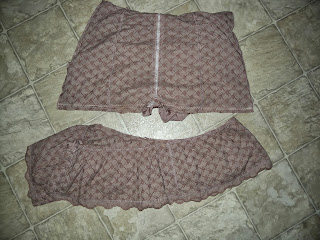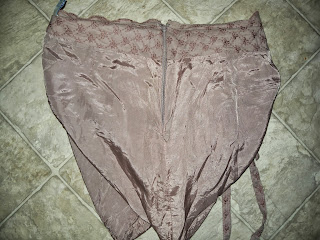Time: 6 hours
I had this old light blue sweater that was given to me by my mom. It was a little too soccer mom-ish for me so it just sat buried in the back of my closet. I recently pulled it out and came up with a project to turn it into a dress for fall. We are having beautiful fall weather right now, and I have been enjoying wearing all kinds of skirt-and-tights combinations. The nice weather is supposed to last clear till this weekend, so I wanted one more outfit.
I chopped off what I considered to be the most hideous part of the sweater, which was the collar. I also cut the sleeves and made them short. I unraveled one of the sleeve to use the yarn for the next steps. To finish off the short sleeves, I unraveled them until both were the same length and ended in a single row of open knit loops.
I took a yarn needle and threaded a piece of yarn through each open loop to stop the unraveling, and stitched the ends, making it a little extra tight to give the sleeves some puff.
Next I took a strip of ribbon made of a material which I cannot name (see the picture), and wrapped the yarn around it 3 times. I took a very thin piece of ribbon and sewed it down the middle on the machine, and then cute the edges on both sides with a razor knife. Then I cut and removed one side of the ribbon strip. The result was a long fuzzy stretch of yarn which I was then able to hand-stitch to the edges of the sleeves and neck of the sweater.
I took a yarn needle and threaded a piece of yarn through each open loop to stop the unraveling, and stitched the ends, making it a little extra tight to give the sleeves some puff.
Next I took a strip of ribbon made of a material which I cannot name (see the picture), and wrapped the yarn around it 3 times. I took a very thin piece of ribbon and sewed it down the middle on the machine, and then cute the edges on both sides with a razor knife. Then I cut and removed one side of the ribbon strip. The result was a long fuzzy stretch of yarn which I was then able to hand-stitch to the edges of the sleeves and neck of the sweater.
The sweater on its own could have been a refashion, but I wanted it to be a dress, so I made a quick trip to a fabric store I really like here in Portland. I picked out polka-dot patterned fabric in a similar shade of blue for the skirt bottom. As I explained my project to the store attendant she advised me to get a walking foot for my sewing machine, because sewing knit on cotton could lead to bunching up of the fabric due to differences in how easily they are pulled by the machine. The walking foot pulls the fabric from the top so both top and bottom get pulled at the same speed. So I followed her advice, and was amazed with how well the walking foot worked! It even allowed me to sew in much straighter lines too! I had always thought my sewing skills were not very good, but now I realized that part of the problem was the machine – not me. That was definitely something worth finding out. Now I’m feeling more empowered to tackle a more challenging project. To finish the dress, instead of hemming the skirt, I stitched a thick embroidered line across the bottom and trimmed the remaining fabric.
 This dress turned out to be a lot more work than I had anticipated, but it was worth every minute spent on it. It has become one of my favorite refashions! I wore it together with my bird’s nest necklace to my friend K’s twins, J and T’s birthday party.
This dress turned out to be a lot more work than I had anticipated, but it was worth every minute spent on it. It has become one of my favorite refashions! I wore it together with my bird’s nest necklace to my friend K’s twins, J and T’s birthday party. 














































